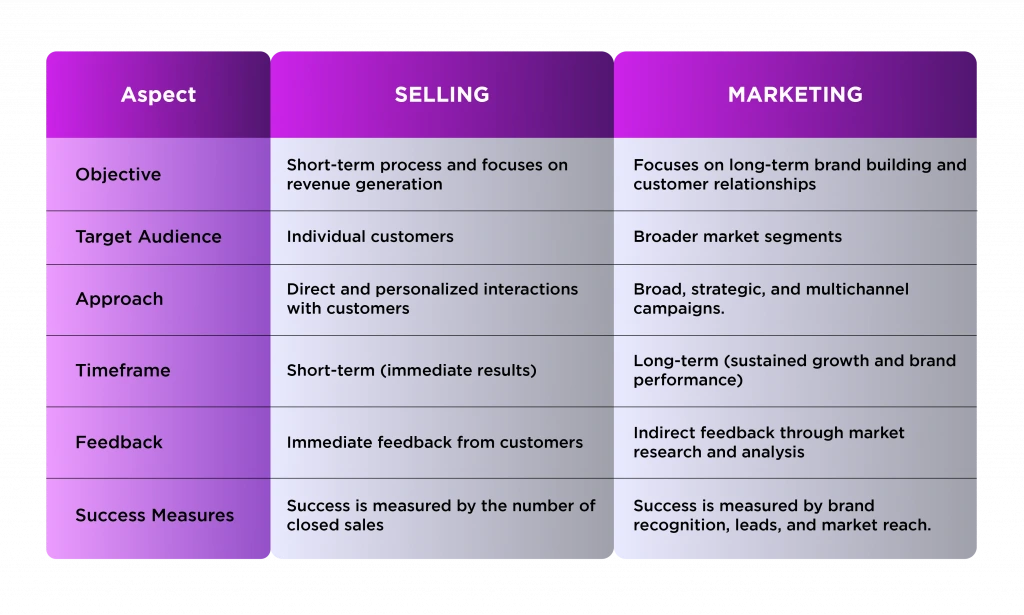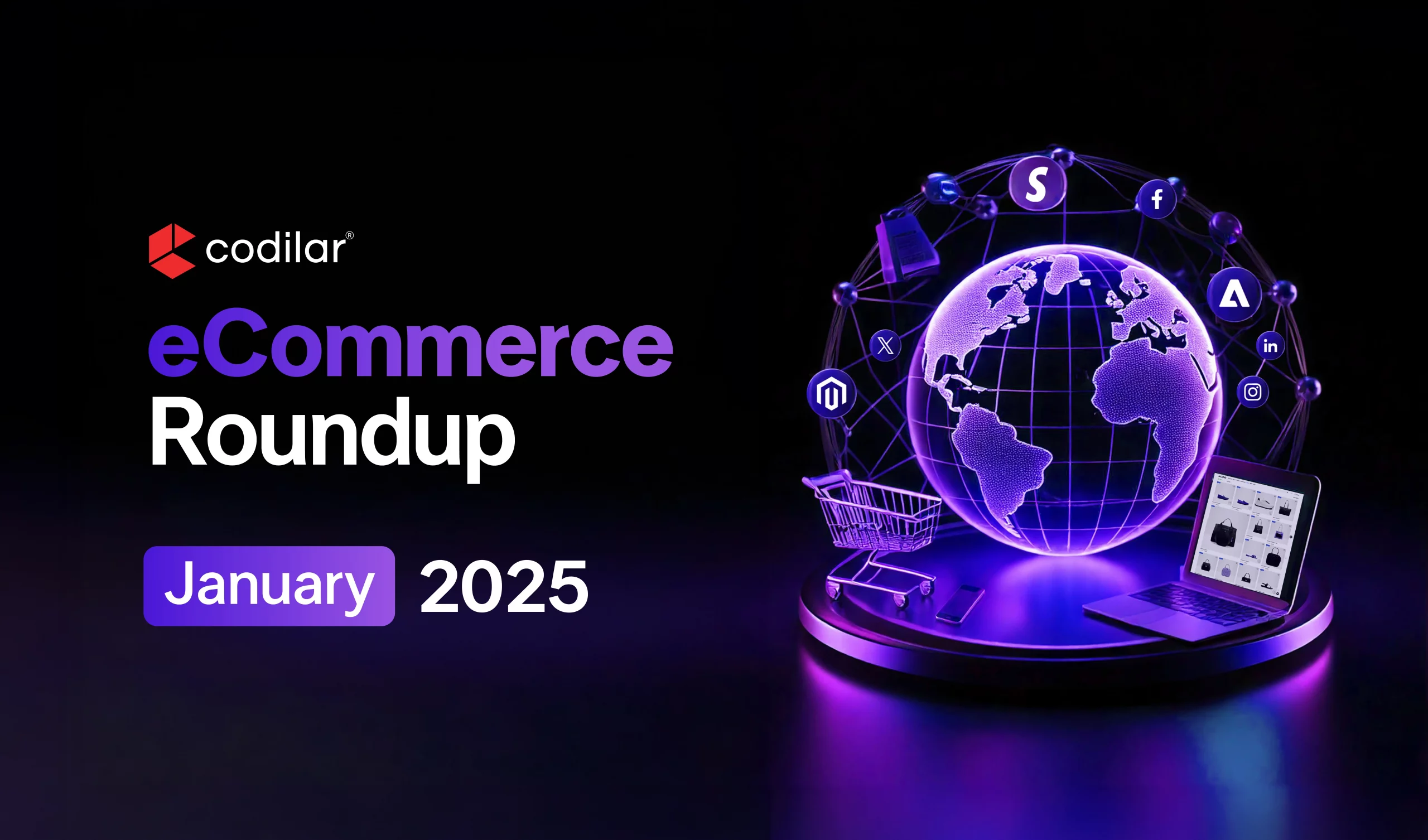We often come across the terms marketing and selling. Both are integral to running a successful business, yet they are often used interchangeably. But are they truly the same?
Marketing is the art of building a brand, attracting customers, and creating a loyal customer base. It operates at the top of the sales funnel, focusing on creating awareness and interest. Selling, on the other hand, takes place toward the end of the funnel, where the focus shifts to closing deals and driving revenue. While marketing works behind the scenes, crafting the narrative and setting the stage, selling is performance in the spotlight!
It is important for businesses to recognize the difference between marketing and selling. This not only helps in formulating effective strategies but also plays a key role in improving performance and contributes to long-term revenue growth.
What Is MARKETING?
Marketing is an umbrella that covers many important aspects of developing a successful brand such as:
- Identifying and understanding customer needs
- Creating a product that meets their requirements or adds value
- Identifying target audiences
Marketing is a continuous process that begins even before the product is actually in the works and extends well beyond its launch.
It is all about putting the customer first. Marketing focuses on understanding their behaviour, preferences, and requirements to create meaningful connections. By prioritizing this, businesses can not only meet customer expectations but also build long-term customer loyalty.
Unlike one-time efforts, marketing is a strategic, ongoing process that is focused on reaching a widespread and diverse audience. This is achieved through the multi-channel approach, ensuring the brand’s message resonates with the viewers across various platforms. With a customer-centric approach, marketing doesn’t just promote and launch products; it builds trust, boosts visibility, and drives growth.
Types of Marketing
Marketing includes different strategies to connect with customers and grow a business. Here are some of the different types prevalent in the industry:
- Digital Marketing
- Social Media Marketing
- Content Marketing
- Email Marketing
- Influencer Marketing
- Print Media Publication
Examples of Marketing
Social Media Campaigns and Influencer Collaborations
Social is the most influential marketing channel today. Brands leverage platforms like Instagram to promote new products through ads with engaging visuals and influencer collaborations, making it one of the most prominent marketing trends of the era.
Content Marketing
Businesses today can share content with their audience today with a blog post or video tutorial demonstrating how to use their product or related content, like a fitness equipment guide for instance.
Event Sponsorship
Many big brands sponsor sports events to enhance their visibility, expand their reach, and connect with new audiences. These sponsorships provide a platform to showcase their logo, messaging, and products to a variety of potential customers, fostering brand recognition.
Product Launch Campaigns
Apple stands as the prime example of an exceptional product launch marketing campaign. With every new product release Apple hosts a highly anticipated event where the audience gets a first-hand look of the latest innovations and gadget updates for the year.
Loyalty Programs
Starbucks effectively promotes its rewards program by leveraging email marketing and app notifications. These personalized messages keep customers engaged, offering exclusive deals, updates, and incentives that encourage repeat purchases and boost customer loyalty.
The Importance of Marketing
Promoting Brand Awareness
Marketing helps establish your brand in the minds of consumers. Whether through social media, advertising, or other content forms, it ensures that your business is visible and creates an impact in a crowded marketplace. Good marketing essentially puts your brand on the map. Take Coca-Cola, for instance- be it billboards, TV ads, or social media, the brand ensures their product sticks with the viewers and is synonymous with joy!
Market Research
Another reason why marketing is essential is market research. Marketing involves understanding what the audience needs and values. A good example is Netflix, which uses customer data to identify viewer preferences and trends and make recommendations accordingly. This personalized approach leads to customer engagement and loyalty.
Building Long-Term Customer Relations
Businesses understand that marketing isn’t primarily focused on making sales, but it is all about connecting with the audiences. The Starbucks’ reward program is the best example for this. This prodigious coffeehouse chain offers customers personalized deals and incentives, encouraging them to keep returning. This customer loyalty translates to long-term success.
Gain a Competitive Edge
A strong marketing plan helps you stand out from your competitors. Crafting an effective marketing strategy can help businesses create a lasting impression on the viewer by addressing their pain points and the value their product has to offer. This helps position the brand as the preferred choice in the industry.
Driving Growth
Although we have stated that marketing and sales are very different from one another, marketing does directly impact sales. With creative marketing, businesses can attract more customers, retain existing ones, and further create opportunities for upselling and cross-selling. In the long run, good marketing drives revenue and ensures business growth.
After putting an exceptional marketing strategy in place, your product/service has hit the stores; the next step is crucial—this is where selling comes into play.
What is SELLING?
By definition, selling is purely a transactional process, where businesses motivate the customer to purchase the product. It involves a direct interaction between the potential buyer and the business, focused on converting an interested viewer into a customer. By persuading consumers to buy the product/service, selling achieves its primary goal: closing the deal and contributing to immediate growth in revenue.
A stark difference between selling and marketing is that selling focuses on short-term gains while marketing is designed for long-term growth. While marketing creates product awareness and generates leads, selling ensures those leads are converted into loyal customers. In this sense, you can say that selling is the final step in the marketing strategy, as all the marketing efforts ultimately culminate in sales.
Types of Selling
Here’s a breakdown of a few different types of selling:
- B2B selling
- B2C Sales
- Retail
- Telemarketing
- Door-to-door selling
- Online Sales
Examples of Selling
Upselling In a Retail Store
salesperson at a store assisting a customer in choosing and purchasing products, such as recommending electronic gadgets, like a laptop, that align with the customer’s specific needs and preferences.
Cold Calling
Telesales is a common technique used to reach out to a potential customer to pitch a new product and its benefits. For example, it could be a card upgrade for your credit card and what other features and benefits are offered with it.
Seasonal Deals
Flash sales and big discounts offered during festive seasons or major events often drive the largest revenue for most eCommerce stores. These limited-period offers create a sense of urgency, encouraging shoppers to make a quick purchase.
B2B Sales
Imagine a sales representative meeting with a corporate client to showcase the benefits of a business software solution. Through a customized pitch and tailored solutions that address the client’s specific needs, the representative convinces the client to commit to the yearly subscription making way for a long term collaboration.
The Importance of Selling
Generation of Revenue
Selling brings revenue for any business. Even the best marketing strategies won’t matter if they don’t result in sales. For instance, imagine a software company that offers a subscription-based service. While marketing might attract potential users to the website, it is the sales team’s efforts—through product demos, tailored pricing packages, or follow-up communications—that ultimately convert those leads into paying customers, driving the company’s revenue.
Forge Customer Relationships
Selling involves direct communication with customers, making it an excellent opportunity to build trust and rapport. Your salesperson is your ultimate product ambassador. When your sales team forges a one-on-one relationship with your customers, it lays the foundation for strong, long-lasting customer relationships. A salesperson who genuinely understands a customer’s needs and delivers value earns not just a sale but loyalty and goodwill.
Receive Immediate Feedback
Sales interactions provide businesses with real-time insights into customer preferences and expectations. For instance, feedback during a sales pitch can highlight potential improvements to a product or identify trends in customer behaviour, enabling your business to switch strategies if need be and adapt quickly.
Enhance Brand Reputation
Your salesperson represents your brand. The success of your sales efforts lies in your team’s brand knowledge, professionalism, and customer-centric approach, all of which make a significant impact on how your brand is perceived. Positive sales experiences not only lead to satisfied customers but also turn them into your most influential endorsers and supporters, helping strengthen your brand’s reputation in the market.
Increase Market Shares
Consistent and effective selling helps businesses capture a large share of the market. By converting potential customers into buyers and retaining the existing customer base, selling contributes to expanding the company’s foothold in the industry.
Here are the prime differences between selling and marketing:

In conclusion, marketing and selling are both crucial for business success. While marketing generates awareness and attracts potential buyers, selling focuses on converting those prospects into immediate profitable transactions. A strong marketing strategy lays the groundwork for sales, setting the stage for sustained growth and success.










